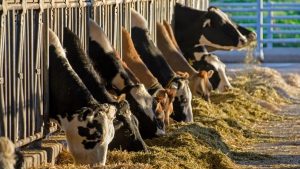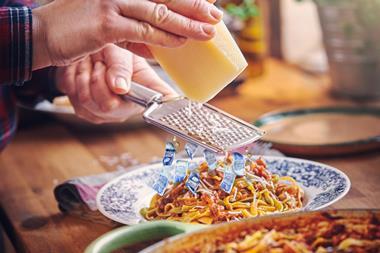
Dramatic price spikes across Continental cheese are shaving off sales of classic Italian lines. And droughts could force up prices further
Mamma mia! Rampant price inflation has spelled bad news for shoppers who like a generous sprinkle of parmesan on their pasta or extra mozzarella on their pizza.
The average price per kilo of these Italian classics has soared in the past year – by 11.5% and 24.1% respectively [Kantar 52 w/e 14 May 2023] – forcing consumers to make some tough decisions about what they put in their baskets.
“The large increases in the average price of Continental cheeses have … led to drops in frequency and penetration,” explains Heloise Le Norcy-Trott, group marketing director for Lactalis UK & Ireland.
Volumes have fallen 6.4% for parmesan and 2.5% for mozzarella, while total Continental cheese volumes have fallen 5.5% [Kantar]. So what’s behind this pricey picture?
Several factors are at play here – including the ones hitting grocery in its entirety. “The rising costs of energy, feed, packaging and salaries have made products considerably more expensive,” confirms Craig Brayshaw, MD at Eurilait.
But there are also category-specific factors. HRA Global MD Hamish Renton cites volatility in European milk prices due to the war in Ukraine, which has resulted in milk supplies moving eastwards to plug the gap.
That’s left tighter supplies across the rest of the continent. Renton points to the premium end of the market for parmesan as an example – although its price rises are modest compared to brie (40.4%), gouda (33.6%) and, of course, mozzarella.
Against these rising prices, own label is gaining ground at the expense of brands. Private label Continental sales have risen from £615.9m to £709.6m. That means they now account for nearly 80% of total market value [Kantar].
“Own label ranges have been some of the top performers in the latest year”
Granted, those gains are down to price rises. But volumes have fallen slower than brands – at 5.4% versus 6.4%.
“As a result, own label ranges have been some of the top performers in the latest year.”
Nicholas points to Co-op British Goats Cheese and Morrisons Grated Mozzarella & Cheddar Mix as examples of successful lines.
The trend is perhaps most pronounced in parmesan and mozzarella, though. Here, own label volume declines have been far slower than the wider market. They’re down 5.6% and 0.8% respectively – significantly outperforming brands, which have suffered sizeable slumps of 21.6% and 22%.
But own label or branded, there’s no denying it’s a tough time for anyone in Continental cheese. The industry is now upping its efforts to attract price-sensitive shoppers.
And makers of parmesan are also in line for a publicity boost. In August, the Parmigiano Reggiano Consortium kicked off a three-year campaign to promote the hard cheese and its protected designation origin status. The €3.6m (£3.1m) push, co-funded by the EU, is aimed at educating UK consumers on parmesan’s versatility.
“It might sound contradictory, but while prices are increasing, premiumisation drives growth”
There are other cheeses, however, with sales less in need of a fillip. Among those to have defied the inflationary environment, delivering growth in both volumes and value, are feta, salad cheese, and maasdam.
Brayshaw at Eurilait points out “feta and, in particular, salad cheese, has offered the consumer a meat-free option for lighter dishes”, while “the consumer movement to the discounters who stock maasdam in convenient slices has resulted in the volume growth during the cost of living crisis”.
Tellingly, these cheeses are also less expensive than many Continental alternatives. While parmesan comes in at £19.42 per kilo, maasdam is £7.61 and feta is £9.14 [Kantar]. Cheapest of all is feta-style salad cheese, which boasts the lowest average price per kilo of any Continental cheese: £4.90.
“With bringing people together at the core of Nurishh’s mission, we’re not a brand for vegans only. We’re a brand for everyone,” insists Justine de Monès, Bel UK marketing manager for fruits & culinary solutions.
- Spend on Continental cheese has reached £893.6m – an all-time high. But that’s almost entirely due to a 20.1% rise in average price per kg. Volume sales have fallen 5.5%.
- “Shoppers are trading down to reduce their grocery bills,” explains Kantar analyst Jamie Nicholas. They are “also shopping less frequently and buying less per trip”.
- Hard variants have borne the brunt: volumes have dived 10.2%. Within the sector, manchego and edam have suffered most, with 31.9% and 21.2% declines respectively. Volumes of soft Continental, meanwhile, have fallen 3.1%.
- However, some variants have defied “this bleak outlook” to deliver volume growth, notes Nicholas. That’s seen in gains for the likes of grana padano (18%) and maasdam (7.1%) – largely thanks to strong showings in own label.
- Inflationary pressures are driving private label’s performance, says Nicholas. Own label Continental is up 15.2% in value, over double the 7.3% rate of brands. And volumes have fallen at a slower rate: 5.4% versus 6.4%.
Future pricing
The price point of its new cubes – £2.70 for 150g – could just be crucial. Because many believe price will remain a defining factor in the year ahead.
The record-breaking heatwave in southern Europe this summer has affected milk production, Renton warns. “Supply over the summer is super tight, and that is going to feed into some pretty sharp rises in European cheese,” he predicts.
Similarly, Le Norcy-Trott predicts ongoing inflationary pressures will have a significant impact on sales, pricing and ranging. “As we are seeing in many grocery categories, when consumers face higher prices, they tend to cope by trading down to cheaper products, switching retailers, buying more on promotion, or simply buying fewer items.”
“It might sound contradictory, but while grocery prices are increasing and dairy consumers might choose to purchase fewer units of cheese – including Continental cheeses like mozzarella – premiumisation can still drive growth.”
That could be good news for makers of pricier parmesan.




















